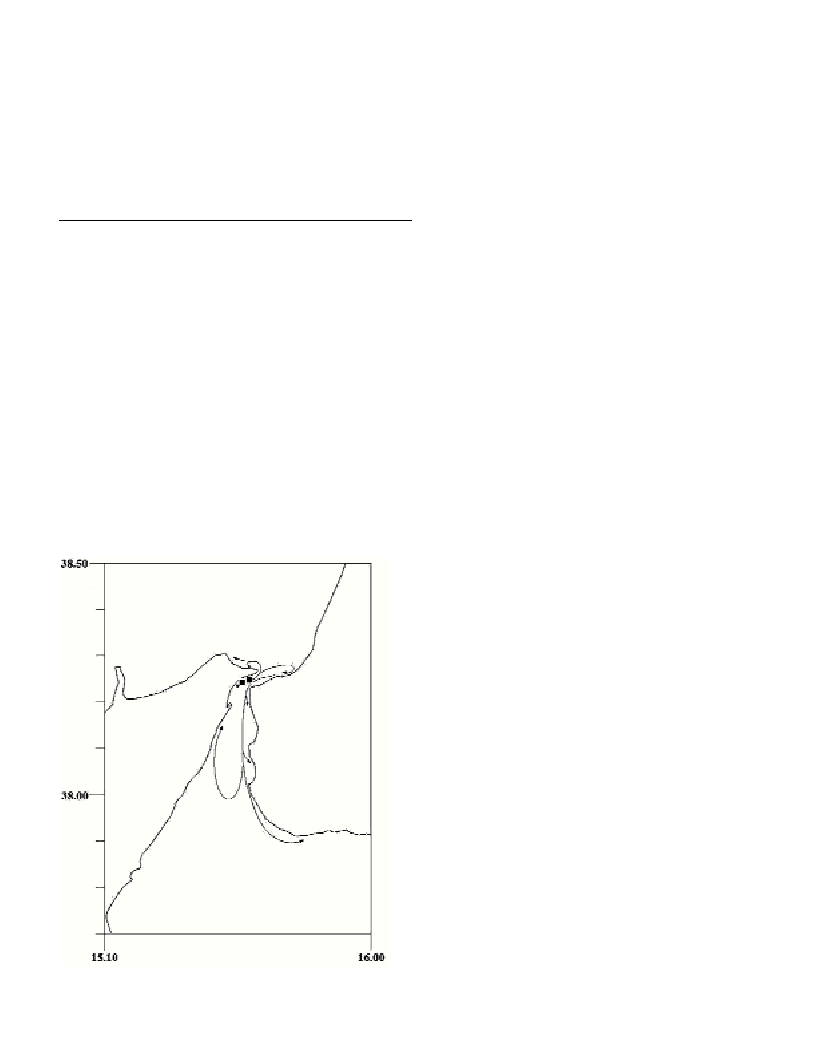THE FIRST FIND OF PORTUNUS PELAGICUS (DECAPODA, BRACHYURA)
IN THE STRAITS OF MESSINA (CENTRAL MEDITERRANEAN SEA)
Antonio Bonanno, Francesca De Domenico, Adriana Profeta and Nunziacarla Spanò*
Dipartimento di Biologia Animale ed Ecologia Marina, Università degli Studi di Messina, S. Agata Messina, Italia - * spano@unime.it
Abstract
Portunus pelagicuswas collected during a survey carried out in the Straits of Messina in the autumn of 2002. This is the first find of this
species for this area. Four specimens were caught at two different stations at 25 and 40 m depth, respectively, in the soft bottom colonized
by Caulerpa taxifolia. In this paper the physical characteristics of water and sediment are reported. Finally considerations on the relevant
changes in the benthic environment following the settlement of Caulerpa taxifoliaprairies, are reported.
Key-words: Straits of Messina, Caulerpa taxifolia, Portunus pelagicus
Rapp. Comm. int. Mer Médit., 37,2004
495
Introduction
Four specimens of the brachyuran crab Portunus pelagicus(L.)
(Decapoda, Brachyura, Portunidae), 3 male and 1 female, were found
along the Sicilian coasts of Straits of Messina (Central Mediterranean
Sea) during a research project entitled “Anomalie biotiche e abiotiche
nello Stretto di Messina”, carried out in the 2001-2003 years. The aim
of this project is the benthic modifications caused for invasion of
alloctonous species Caulerpa taxifolia (Vahl) C. Agardh. This find,
the first from the Straits of Messina, contributes to the knowledge of
distribution of P. pelagicus.
Methods and materials
The sampling was carried out by scuba divers along the Sicilian
coasts from Capo Peloro to Torrente Annunziata (Fig. 1). A total of 31
samples was taken at a depth of 7-60 m in the years from 1999 to
2003. For each samples 50dm
3
of sediment were taken, on the surface
area of 0.25m
2
. Specimens of benthic macrofauna collected were
fixed in 70% alcohol solution in the laboratory. At both stations
temperature and salinity were measured using a multiparameters
probe. Sediment samples collected were used for granulometric
analysis (1).
Moreover were carried out video recording by scuba divers, for
monitoring the distribution of Caulerpa taxifoliain the Straits of
Messina.
Results and discussion
The analysis carried out on the benthic macrofauna found on
Caulerpa taxifolia, showed 38 species and 369 specimens of
crustacea decapoda. In total, four specimens of Portunus pelagicus
were collected at 31 sampling stations.
The specimens were caught in the northern part of Straits of
Messina at 25 and 40 m depth in front of Ganzirri village.
The granulometric features of this site showed coarse sand
sediment. The values of salinity and temperature are reported: 37.8%
and 26°C respectively for both sites.
The other species of decapods are reported in the same stations:
Alpheus macrocheles, Dardanus arrosor, Eurynome aspera,
Parthenope massena andXantho poressa.
The Straits of Messina represent a junction of the two basin, the
Ionian one and the Tyrrhenian one. This is a peculiar environment
which the hydrological regime has a fundamental role in the
distribution of the benthic populations. Moreover the topography and
hydrodynamic level of this area allow the establishment of
communities exclusive to the Mediterranean Sea (2; 3).
The presence of Caulerpa taxifoliahas been reported in The Straits
of Messina since 1993 (4; 5).
In general, the investigations in the Straits of Messina on
macrozoobenthic communities (crustacea decapoda) of Caulerpa
taxifoliashowed an increase of number of species and specimens. On
the contrary the populations, variable and heterogeneous are
destructured and still changing (6).
The presence in such sample of atlantic species must be noted, as
Parthenope expansaand Pilumnus inermisalready reported in this
area (7; 8). It is very important this record of the lessepsian species P.
pelagicusin the Straits of Messina. The presence of atlantic and
lessepsian species in the Straits of Messina is an other evidence of the
importance of this zone, which are reported the eastern and western
migratory ?ows.
Acknowledgements. We would like to thank particularly G. Iaria
for the diving center OLOTURIA SUB from Messina for their helpful
collaboration during the sea operations.
References
1-Folk R.L. and Ward W.C., 1957. Brazos river bar: study in the
significance of grain size parameters. Journ. Sed. Petr..27 (1): 2-26.
2-Fredj G. and Giaccone G., 1987. Bionomie des fonds a Laminaires du
Détroit de Messine, Doc. et Trav. IGAL.11: 237-238.
3-Di Geronimo S.I. and Fredj. G., 1987. Les fonds à Errina asperaet
Pachylasma giganteum, Doc. et Trav. IGAL.11: 243-247.
4-Fradà Orestano C., Calvo S. and Ferreri B.M., 1994. First record of
Caulerpa taxifolia(Vahl) C. Agardh in the southwestern Mediterranean.
Giorn. Bot. Ital., 128 (3-4): 813-815.
5-Fradà Orestano C., Pirrotta M. and Ammirato E., 2001. Spread of
Caulerpa taxifoliain Sicily and Calabria (Italy). Fourth International
Workshop on Caulerpa taxifolia, GIS Posidonie publ., Fr., pp. 78-84.
6-Guglielmo R., Giacobbe S., Spanò N. and Manganaro A., 2002.
Comunità macrozoobentoniche associate a Caulerpa taxifolia(Vahl) C.
Agardh nello Stretto di Messina: primi risultati. Biol. Mar. Medit.,in press.
7-Spanò N., 2002. Presenza di Parthenope expansa(Miers, 1879) (Deca-
poda: Parthenopidae) nello Stretto di Messina. Biol. Mar. Medit., 9(1).
8-Giacobbe S. and Spanò N., 2001. Pilumnus inermis(Decapoda,
Brachyura) in the Straits of Messina and the Southern Tyrrhenian Sea
(Mediterranean Sea): distribution and some aspects of its ecology.
Crustaceana, 74 (7): 659-672.
Fig. 1. Monitoring distribution of Caulerpa taxifolia in the Straits of
Messina in the year 2003. Squares show sampling stations of Portunus
pelagicus.

